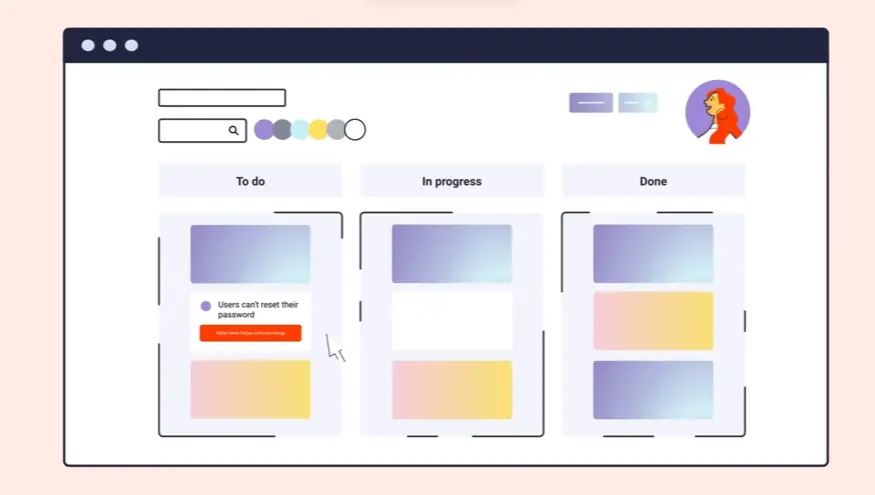1. Mambu
Duration : 1 minute and 46 seconds
Composable banking explainer animation provides a concise, strategic overview of Mambu's vision, demonstrating how its composable banking framework empowers financial institutions to shed legacy constraints and embrace agile, customer-centric innovation. Through dynamic motion graphics and compelling visual metaphors, the video articulates a clear path to future-proof financial services delivery.
Why It Stands Out:
Architecting Clarity Through Dynamic Visuals: Mambu's animation excels by using sophisticated procedural animation and abstract geometric forms to deconstruct complex architectural concepts. This visually contrasts rigid, "monolithic" systems with dynamic, interconnected modules, making the abstract benefits of composable banking instantly comprehensible and engaging.
Empowering Agility and Market Speed: The video strategically frames Mambu's solution as the key to overcoming the "unprecedented pace of change" in banking. It highlights the ability to combine independent systems and achieve flexible assembly, directly addressing C-suite concerns around speed-to-market and operational agility in a rapidly evolving financial landscape.
* Composing Standout Customer Experiences: By emphasizing the choice of best-of-breed vendors and the ability to swap components, the narrative positions Mambu as an enabler for creating highly personalized and standout customer experiences. This demonstrates how financial institutions can "compose the bank they want to be," fostering innovation and loyalty beyond generic offerings.
2. Orbitkey, Cinematic story video
Duration : 44 seconds
Star Wars Orbitkey product video transforms everyday carry into an epic quest for balance, seamlessly blending iconic film footage with high-fidelity CGI product animation. This strategic marketing piece elevates Orbitkey as the ultimate tool to "balance your force," turning chaotic, jangling keys into a sleek, silent, and organized solution without a single word of narration.
Why It Stands Out:
Weaving Brand Narrative with Galactic Lore: Orbitkey brilliantly leverages the deep emotional connection and narrative richness of the Star Wars IP. By drawing parallels between the cosmic struggle of Light vs. Dark and the daily challenge of personal organization, the video positions Orbitkey not just as a product, but as an aspirational symbol for bringing order and purpose to one's personal "galaxy."
Transforming Chaos into Silent Efficiency: Through compelling visual juxtaposition, the video dramatizes the journey from noisy, jumbled keys€”a metaphor for everyday clutter€”to the streamlined, quiet elegance of the Orbitkey organizer. Meticulous close-ups and deliberate animation showcase the product's compact functionality, effectively communicating its core benefit of silent, efficient key management and reinforcing the powerful "balance your force" tagline.
* Lightsaber Aesthetics: Product as Icon: This video employs sophisticated cinematic techniques, including seamless integration of licensed Star Wars footage, striking blue and red thematic color grading, and "lightsaber glow" transitions. This expert technical execution and immersive sound design elevate the Orbitkey product itself, presenting it as a high-tech artifact imbued with the iconic visual and auditory signatures of the Star Wars universe.
3. EcoFlow Customer storytelling video
Duration : 14 seconds
Amplify your perception of energy possibilities, as EcoFlow's video dynamically showcases power redefined. Transitioning from a common toaster to powering a whole house, the visual narrative immediately establishes a spectrum of capability. It's not merely about wattage; it's a visual language speaking to adaptability and robust energy independence.
This compelling customer storytelling video frames DELTA Pro not just as a device, but as a gateway to versatile living. The design emphasizes mobility, suggesting a life unbound by power constraints, ready for any scenario from outdoor escapades to home resilience. EcoFlow inspires viewers to envision a life empowered, offering a potent example for impactful video communication .
4. nanocare Dryer Explainer storytelling video
Duration : 31 seconds
sustainable beauty product storytelling. The Panasonic nanocare Dryer video masterfully blends advanced haircare technology with a profound commitment to environmental responsibility. Through ethereal abstract visuals and macro nature cinematography, it constructs a compelling narrative that elevates the product beyond utility, positioning it as a conscious, high-performance choice for the discerning, eco-aware consumer.
Why It Stands Out:
Visualizing Eco-Innovation with Plant-Derived Materials: The video employs sophisticated abstract fluid animation and an expanding ink-blot effect to visually communicate the use of plant-derived components and "Biomass Paint." This seamless integration of organic textures and sleek product rendering transforms complex technical advancements into an accessible, visually compelling story of sustainability for the nanocare Dryer.
Elevating Beauty Through Environmental Stewardship: Rather than focusing on hair styling, the narrative strategically highlights Panasonic's "Taking Action for the Environment." By connecting personal beauty with a broader eco-conscious ethos, the nanocare Dryer is presented as a responsible luxury, fostering an emotional bond with consumers who value both effectiveness and ecological impact.
* Crafting Aspirational Lifestyle Through Seamless Storytelling: The video's serene pacing, minimalist aesthetic, and calming soundtrack create an aspirational lifestyle message. Concise on-screen text and elegant transitions convey key brand values, positioning the Panasonic nanocare Dryer as an emblem of modern sophistication and a thoughtful investment in both personal well-being and planetary health.
5. Square 9 Product storytelling video
Duration : 1 minute and 30 seconds
Immediately apparent is how Square 9's video transforms the daunting task of document management into an accessible digital journey. It skillfully illustrates the everyday chaos of paper-laden offices, connecting instantly with viewers facing similar challenges. The presentation visualizes Square 9 as a powerful ally, offering a clear pathway to regain control and efficiency in the digital workspace.
Through dynamic visuals , the video narrative becomes a compelling Product Storytelling Video. It smoothly transitions from paper problems to digital solutions, showing how Square 9 streamlines workflows with intuitive tools. This approach resonates by demonstrating a practical escape from paperwork burdens, promising a future of organized, easily accessible information at your fingertips, inspiring viewers to envision their own streamlined operations .
6. Clearblue Testimonial story video
Duration : 11 seconds
Empowering journeys begin with understanding, and Clearblue's video excels at providing just that. Celebrating the initiative to naturally conceive, the video illuminates the often-mystified process of finding one's fertile days. The clarity in visually presenting hormonal cycles makes complex biology feel remarkably approachable.
Driven by a desire to reassure, the video adopts a style akin to a testimonial story video, offering quiet confidence. The iconic smiley face on the Clearblue test isn't just an indicator; it becomes a beacon of hope and informed decision-making. This transforms a potentially anxious phase into one marked by empowerment, showcasing the product as a partner in personal planning.
Through its concise and emotionally intelligent communication, Clearblue offers more than a product demo. It presents a message of informed hope, making the path to pregnancy feel less daunting and more navigable. The video's strength lies in its ability to connect with viewers on a personal level while delivering clear, scientific information.
7. REF650 Visual presentation video
Duration : 1 minute and 31 seconds
Unveiling a solution for modern energy demands, Hitachi Energy's REF650 steps into the spotlight. The video masterfully avoids technical jargon, instead offering a visual presentation video that immediately grabs attention with its depiction of complex electrical grids and substations. It smartly underscores the increasing need for sophisticated automation in today's power distribution landscape.
Positioning REF650 as more than just a product, the presentation highlights it as an essential ally for navigating the future of energy. The offering promises tangible benefits - enhanced reliability, flexibility, and robust security - all leading to optimized operations and significant cost savings. This insightful approach reframes REF650 from a mere device to a strategic enabler for future-ready power networks.
8. Trimble Visual storytelling video
Duration : 1 minute and 49 seconds
Data-driven fleet performance optimization becomes intuitive with Trimbles Performance Portal, a powerful visual storytelling tool designed to reduce fuel costs and CO2 emissions. This animated explainer deconstructs complex telematics data, presenting it as actionable insights for transport companies to improve driver behavior and achieve measurable sustainability goals.
Why It Stands Out:
Transforming Raw Data into Strategic Clarity: Trimbles video excels with a dynamic "data funnel" animation that visually processes raw telemetry from sudden braking to idling into measurable Key Performance Indicators. This clear visual hierarchy simplifies complex information, providing fleet managers with strategic insights to identify cost-saving opportunities and enhance operational efficiency.
Gamified Coaching: Empowering Driver Performance: The Performance Portal actively engages drivers through in-truck scorecards and gamification elements, fostering positive competition and awareness. This driver-centric approach, clearly articulated in the video, ensures that behavioral adjustments are motivated and measurable, leading to sustainable improvements in driving habits and overall fleet performance.
* Holistic Impact: Optimizing Costs for a Greener Future: The video powerfully demonstrates the comprehensive impact of Trimbles solution, connecting individual driver improvements to significant company-wide benefits. By tracking and quantifying coaching sessions, the company dashboard provides a unified view of fuel consumption reduction and CO2 emission decreases, highlighting both economic gains and contributions to a greener world.
9. Open International Case study story video
Duration : 3 minutes and 21 seconds
Proactive utility customer engagement is redefined in this Open International case study, which demonstrates how anticipating customer needs through advanced AI transforms traditional service delivery. Utilizing the Open Smartflex platform, the video visually articulates a powerful thesis: by integrating cutting-edge technology and human-centric design, utilities can foster deep customer loyalty and enhance community quality of life.
Why It Stands Out:
Predictive Intelligence: Foresight in Utility Customer Care: Open Smartflex utilizes embedded AI capabilities and pre-configured workflows to analyze customer data and predict situations like impending bill payment issues. This allows Open International to initiate proactive, personalized digital interactions, offering solutions before customers even recognize their need, effectively mitigating stress and improving satisfaction.
Seamless Omni-Channel Journeys: Connecting Every Customer Touchpoint: The video vividly illustrates an end-to-end customer journey, starting with a digital notification and evolving across various channels like SMS, WhatsApp, and Messenger. This showcases Open Smartflex's holistic approach, ensuring a cohesive and consistent experience regardless of the platform, fostering strong, reliable engagement.
* Human-Centric Innovation: Transforming Relationships Through Proactive Support: Through the relatable story of Lewis, a store owner facing financial stress, the video highlights how personalized chatbot interactions provide immediate and practical assistance, such as changing bill due dates or enrolling in payment plans. This demonstrates a revolutionary, human-centered approach to utility service that builds trust and delivers tangible relief.
10. CORVEL Creative story video
Duration : 1 minute and 3 seconds
Human-centric pharmacy benefit management is vividly brought to life in CORVEL's animated explainer, which masterfully contrasts impersonal automation with proactive human intervention. Through engaging visual storytelling, the video proves how expert oversight and collaborative decision-making drive superior patient safety and significant cost savings in workers' compensation claims.
Why It Stands Out:
Human-Powered Pharmacy: Beyond Automation. The animation vividly differentiates CORVEL's service, contrasting generic PBM automation with its "high-touch" approach. It showcases dedicated pharmacy technicians actively engaging with claims and collaborating with pharmacists and doctors via dynamic split-screen compositions, highlighting superior human oversight.
Proactive Intervention for Patient Safety & Savings. CORVEL's video provides clear visual proof of its impact, depicting the rejection of inappropriate drugs and the conversion to more cost-effective alternatives. On-screen text overlays precisely quantify the substantial financial savings and reinforce the enhanced patient safety achieved through meticulous review before prescriptions are filled.
* Clear Differentiation Through Problem-Solution Storytelling. A distinctive color palette shift, from dull automation to vibrant human interaction, drives the compelling problem-solution narrative. This strategic storytelling simplifies complex processes, making CORVEL's value proposition instantly clear and establishing the brand as a proactive risk management partner.
11. CircleCI Visual case study video
Duration : 1 minute and 6 seconds
This CI/CD workflow animation for CircleCI masterfully illustrates how resilient and flexible teams overcome complex development challenges, integrating disparate technology stacks into unified, agile systems. Through sophisticated abstract motion graphics and compelling case studies, the video visually articulates the power of responsive tooling, enabling swift deployment and continuous innovation.
Why It Stands Out:
Visualizing Complex Digital Ecosystems for Seamless Integration: CircleCI translates the abstract challenges of disconnected technology stacks into a clear, compelling visual narrative. Using procedural animation and glowing particle effects, the video demonstrates how disparate elements coalesce into a single, centralized system, showcasing the products ability to simplify overwhelming complexity.
Accelerating Agile Development and Responsive Solutions: The animation expertly conveys the speed and efficiency enabled by CircleCI. Dynamic, code-like sequences illustrate collaborative problem-solving and rapid deployment of fixes, highlighting how teams like Click Mechanic swiftly push updates in response to evolving customer demands and market shifts, maintaining agility and responsiveness.
Building Confidence with Future-Ready Resilience: Beyond technical features, the videos polished production and confident narration build trust in CircleCI. By featuring real-world applications from Condé Nast, it effectively proves the platform's reliability and adaptability, empowering development teams with the resilience to navigate unforeseen challenges and seize new opportunities for growth and innovation.
12. Zensar Visual intro
Duration : 1 minute and 16 seconds
Social housing policy animation, this Zensar video masterfully advocates for affordable and sustainable housing across Europe, framing it as essential for social mobility and environmental responsibility. Through a relatable character's journey, the animation strategically translates complex policy benefits into an empathetic narrative, enhanced by clear data visualization and impactful visual metaphors.
Why It Stands Out:
Empowering Futures: Christine's Journey to Stability Zensar's compelling animation tracks Christine's life, demonstrating how social housing facilitates significant financial savings and access to crucial support like childcare. This personal narrative clearly illustrates how reduced living costs empower individuals to pursue education and career growth, directly contributing to social mobility and a secure future.
Sustainable & Integrated Communities: The Blueprint for Modern Living The video powerfully showcases social housing as a model for holistic community development, featuring energy-efficient, renovated buildings. It emphasizes the creation of diverse, supportive environments that not only reduce carbon footprints but also foster a strong sense of belonging, highlighting Zensar's ability to visualize community-centric benefits.
* Europe's Housing Vision: A Call for Cohesion and Future Progress Transitioning from individual triumph to a continental challenge, the animation uses a striking visual metaphor of Christine as a beacon amidst shadowy figures, underscoring Europe's urgent housing needs. This strategic pivot culminates in a powerful call to action, positioning responsible housing providers as critical to achieving broader European cohesion, fairness, and a sustainable energy transition.
13. AWS Cloud Visual motion graphics video
Duration : 1 minute and 24 seconds
AWS healthcare cloud animation dynamically illustrates how Amazon Web Services (AWS Cloud) empowers patient-centric care by transforming the healthcare and life sciences industry. Through elegant line-art motion graphics, the video meticulously maps the connected journey from scientific discovery and telemedicine to predictive health and personalized patient engagement, all powered by AWS Cloud's comprehensive, secure, and reliable cloud platform.
Why It Stands Out:
Seamlessly Connecting Every Step of the Patient Journey: The animation uses evolving line-art visuals and dynamic pathways to graphically integrate every facet of the patient experience, from telehealth appointments to genomic analysis and proactive health monitoring, emphasizing AWS Cloud's role in a unified care ecosystem.
Powering Next-Gen Health Innovation with Cloud Intelligence: This video showcases how AWS Cloud's comprehensive machine learning capabilities and high-performance computing accelerate scientific discoveries for effective therapeutics and guide precision medicine, visually demonstrating the platform's intelligence in advancing medical frontiers.
* Architecting Secure and Reliable Healthcare Solutions: By highlighting robust data security, compliance, and leveraging the same trusted technologies that transformed Amazon.com, the video firmly establishes AWS Cloud as the mature and dependable foundation for safeguarding protected health information and fueling future digital health transformations.
14. Alation Visual story telling examples
Duration : 1 minute and 19 seconds
A compelling user-friendly metadata solution video, this Alation explainer strategically deconstructs the common frustration of stagnant "data museums" to present its platform as an indispensable, collaborative asset. Through engaging 2D motion graphics and empathetic visual storytelling, the video vividly illustrates how Alation transforms inaccessible metadata into a vibrant, trusted resource, empowering business users and accelerating self-service analytics projects.
Why It Stands Out:
From Data Museum to Dynamic Resource: The videos opening leverages the powerful "data museum" metaphor, depicting unused metadata solutions gathering dust alongside frustrated users. This sets a clear problem state, which Alation then resolves by transforming it into a dynamic, active environment where metadata actively supports business intelligence, ensuring past investments yield future insights.
Empowering Self-Service Data Discovery: Alation is showcased as a highly intuitive "Yelp for data," enabling users to effortlessly search, review, and receive smart recommendations. This innovative approach to information design simplifies complex data discovery, directly tackling the challenges of non-user-friendly systems and spreadsheets, allowing individual business users to confidently drive their own analytics projects.
* Fostering a Thriving Data Community: Beyond technical features, the video emphasizes Alations role in human collaboration, where machine learning seamlessly meets human curation. This creates a foundation for data governance that fosters accurate, consistent, and trusted insights across the organization. The visual shift from solitary frustration to a vibrant, engaged team underscores how Alation cultivates a truly thriving data community.
15. CloudPay Visual story video
Duration : 1 minute and 25 seconds
Cloud payroll global compliance takes on new meaning in CloudPays animated explainer, which strategically transforms the perception of complex global payroll. This video masterfully uses abstract motion graphics and dynamic data visualization to guide viewers from the challenges of fragmented operations to the clarity of a unified, compliant, cloud-based platform, empowering businesses with actionable insights for strategic growth.
Why It Stands Out:
Unifying Global Payroll Operations on a Single Platform: CloudPay adeptly illustrates the transition from disparate, complex global payroll processes to a centralized, singular system. Through compelling visual metaphors of interconnected nodes converging, the video effectively demonstrates how fragmented data and processes are eliminated, ensuring consistent and compliant service across over 120 countries.
Illuminating Payroll with Strategic Data & Analytics: Beyond mere processing, CloudPays solution is highlighted for its ability to provide profound visibility into "what, when, and why" payroll events occur. The animation showcases how data, automation, and compliance coalesce to deliver rich analytics, equipping finance and HR leaders with the necessary intelligence to drive informed business decisions and unlock new levels of efficiency.
* Delivering Consistent Compliance and Operational Efficiency: The video confidently positions CloudPay as the ultimate solution for achieving continuous compliance and increased operational efficiency. By visualizing reduced costs, fewer errors, and a streamlined workflow, the narrative assures viewers that CloudPay transforms administrative burdens into strategic advantages, allowing companies to focus on core growth and minimize risk across their global operations.










